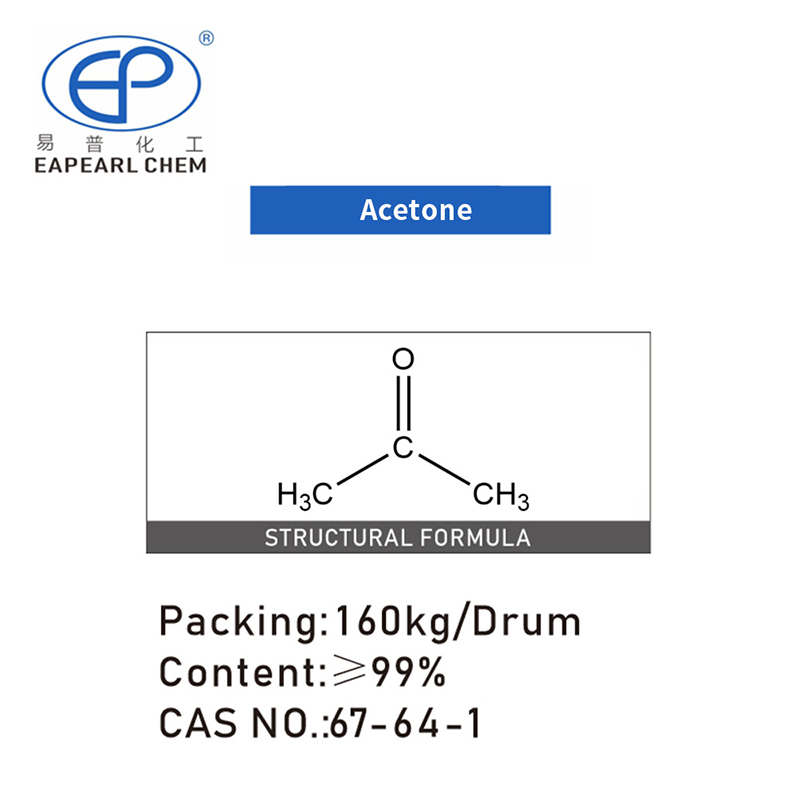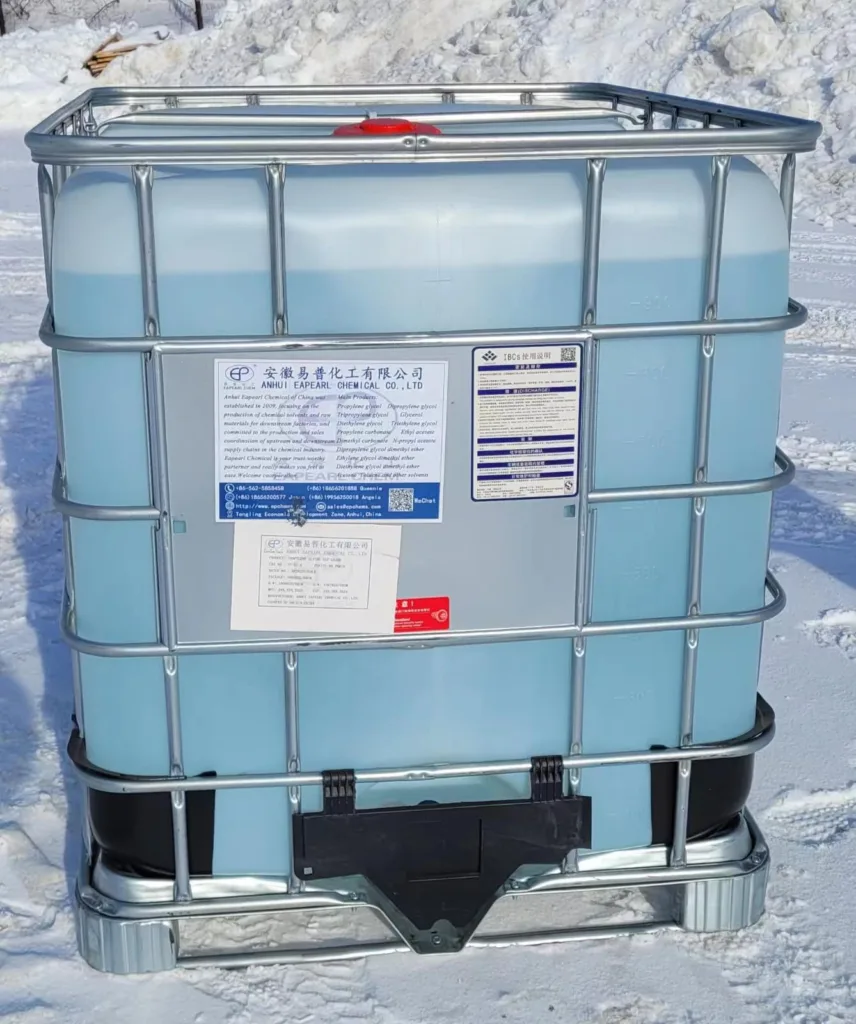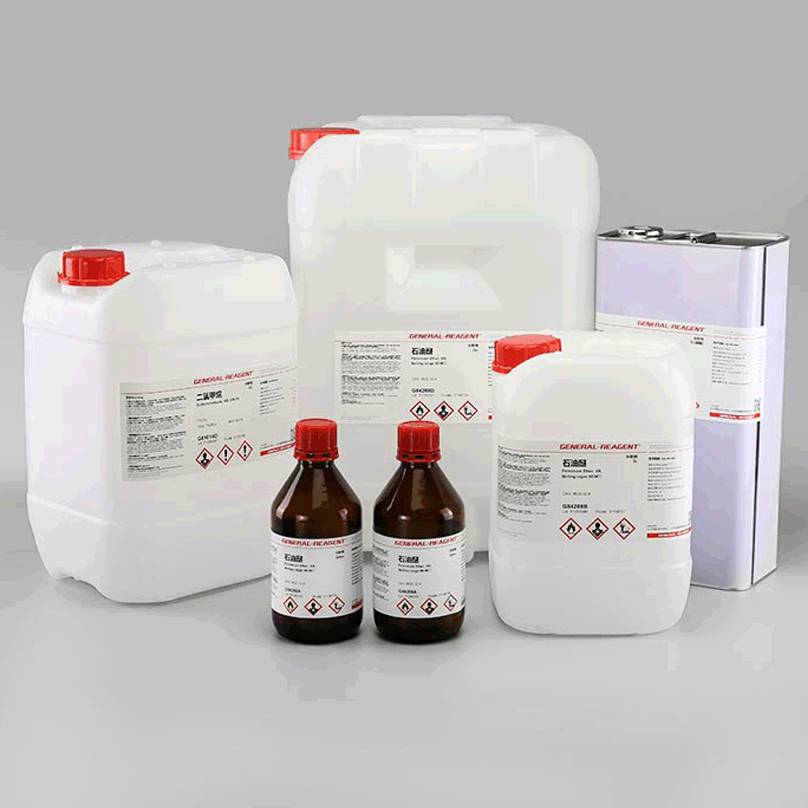Acetone






| Product Name | Acetone |
| CAS | 67-64-1 |
| EINECS | 200-662-2 |
| Chemical Formula | C3H6O |
| Molecular Weight | 58.08 |
| Purity | ≥99.5% |
| Packing | 160kg/drum |
Acetone (also known as Propanone, 2-Propanone, ketonepropane, dimethylketal, Methyl ketone, pyroacetic acid, chevron acetone, beta-ketopropane) is the simplest representative of the group of chemical compounds known as ketones. This organic solvent has a chemical formula C3H6O. It is colorless, pungent, floral or irritating smell, volatile, flammable liquid. It is found in the exhaust from vehicles, plants, trees and forest fires. It is also found in the human body usually present in urine and blood. Acetone is miscible with water and serves as an important laboratory solvent for cleaning purposes. Acetone is a highly effective solvent for many organic compounds such as Methanol, ethanol, ether, chloroform, pyridine, etc., and is the active ingredient in nail polish remover. It is also used to make various plastics, fibers, drugs, and other chemicals.
Eapearl is dedicated to delivering acetone of the highest quality, adhering to stringent manufacturing standards and regulatory compliance. Our acetone products, known for their exceptional quality, consistently meet and surpass customer expectations. At Eapearl, we understand the importance of reliability and timeliness in our deliveries, ensuring that our clients receive our products exactly when they need them. Choosing Eapearl means partnering with a company that values your success as much as its own. We offer unparalleled service and exceptional value, making us a dependable and valuable ally in your business journey. Trust Eapearl to be more than just a supplier – be your partner in achieving success.
Acetone Packaging Information









| Acetone packaging | Capacity | 20GP | 40GP |
| drum | 160 kg /drum | total 80 drums, Net 12.8 ton | total 160 drums, Net 25.6 ton |
| IBC drum | 800 kg /IBC | total 20 IBC, Net 16 ton | total 32 IBC, Net 25.6 ton |
| ISO Tank | 18.5 ton /ISO Tank | 1 ISO Tank, Net 18.5 ton | N/A |
For acetone, we welcome you to test and check the quality, if you need a sample please contact our sales team to discuss your sample requirements, we believe that our product quality is suitable for the specific application. We provide samples free of charge but the shipping cost will be borne by you.
How can we handle your order?



step 1
We will communicate with you within 24 hours after you send an enquiry.



step 2
If you need sample testing, we will send samples within 5 days,≤50kg, Express delivery recommended, usually called as DDU service; delivery time 5-7 days. Door to door service.



step 3
If you need bulk goods after the sample test is qualified, we will ship the goods to the port and keep the samples within 6 days after the order is confirmed. Sea shipping recommended, usually called as FOB, CFR, or CIF service.delivery time 10-45 days. Port to port service.



step 4
After waiting for you to receive the goods, we will arrange professional staff to pay a return visit within 7 days.
Preparation of Acetone



Acetone can be prepared through several methods, both in industrial settings and in the laboratory. In the industry 83% of acetone is produced by cumene process. In the cumene process, benzene is alkylated with propylene to produce cumene, which is oxidized by air to produce phenol and acetone. Here’s a detailed overview of the cumene process:
Cumene Process Overview
Alkylation of Benzene with Propylene:
- The process begins with the alkylation of benzene using propylene. This step produces cumene (isopropylbenzene).
- The reaction typically occurs in the presence of a catalyst, such as solid phosphoric acid or an acidic zeolite.
- The reaction can be represented as follows: C6H6+C3H6→C9H12 (Benzene + Propylene → Cumene)
Oxidation of Cumene:
- The cumene is then oxidized with air.
- This oxidation forms cumene hydroperoxide, an intermediate.
- This step is typically carried out at a moderate temperature and under controlled conditions to prevent undesirable side reactions.
Cleavage of Cumene Hydroperoxide:
- Cumene hydroperoxide is then subjected to an acid-catalyzed cleavage.
- The cleavage reaction yields phenol and acetone.
- The typical catalyst used in this step is sulfuric acid or an acidic ion-exchange resin.
- The reaction can be summarized as: C9H12O2→C6H5OH+C3H6O (Cumene Hydroperoxide → Phenol + Acetone)
At Eapearl, our dedication to precision in the synthesis of acetone ensures a consistent provision of superior quality product. We understand the pivotal role that acetone plays across a multitude of industries—from pharmaceuticals to manufacturing—and we stand by the reliability of our chemical solutions. For inquiries or to engage in detailed discussions about our chemical solutions, we welcome you to reach out to us. Our team of experts is ready to support your needs and offer tailored solutions that drive your success.
Technical of Acetone
| Name | Acetone |
| CAS | 67-64-1 |
| EINECS | 200-662-2 |
| Molecular Formula | C3H6O |
| Molar Mass | 58.08 |
| Density | 0.791g/mL at 25°C(lit.) |
| Melting Point | -94°C(lit.) |
| Boling Point | 56 °C760 mm Hg(lit.) |
| Flash Point | 1°F |
| JECFA Number | 139 |
| Water Solubility | soluble |
| Solubility | Miscible with water and with ethanol (96 per cent). |
| Vapor Presure | 184 mm Hg ( 20 °C) |
| Vapor Density | 2 (vs air) |
| Appearance | Liquid |
| Specific Gravity | 0.79 (25/25℃) |
| Color | Colorless, invisible vapor |
| Odor | Characteristic pungent odor detectable at 33 to 700 ppm (mean = 130 ppm) |
| BRN | 14,66 |
| Storage Condition | Store at +5°C to +30°C. |
| Explosive Limit | 2.6-12.8%(V) |
| Refractive Index | n20/D 1.359(lit.) |
| LogP | -0.16 |
| Toxicity | LD50 in rats: 10.7 ml/kg orally (Smyth) |
| HS Code | 29141100 |
| Hazard Class | 3 |
| Packing Group | II |
| Physical and Chemical Properties | Appearance and properties: colorless, transparent and easy to flow liquid, aromatic odor, volatile. melting point (℃): -94.6 boiling point (℃): 56.5 relative density (water = 1): 0.80 relative vapor density (Air = 1): 2.00 saturated vapor pressure (kPa): 53.32(39.5 ℃) heat of combustion (kJ/mol): 1788.7 critical temperature (℃): 235.5 critical pressure (MPa): 4.72 logarithm of octanol/water partition coefficient: -0.24 flash point (℃): -20 ignition temperature (℃): 465 Upper Explosive limit%(V/V): 2.5 lower explosive limit%(V/V): 13.0 solubility: miscible with water, miscible with ethanol, ether, chloroform, oil, most organic solvents such as hydrocarbons |
| Flammability and Explosibility | Acetone is extremely flammable (NFPA rating = 3), and its vapor can travel a considerable distance to an ignition source and “flash back.” Acetone vapor forms explosive mixtures with air at concentrations of 2 to 13% (by volume). Carbon dioxide or dry chemical extinguishers should be used for acetone fires. |
| pKa | 19.3(at 25℃) |
| Dielectric constant | 1.0(0℃) |
| Merck | 14,66 |
| Exposure limit | TLV-TWA 1780 mg/m3 (750 ppm), STEL2375 mg/m3 (ACGIH); 10 h–TWA 590mg/m3 (250 ppm); IDLH 20,000 ppm(NIOSH). |
| PH | 5-6 (395g/l, H2O, 20°C) |
| Relative polarity | 0.355 |
| Odor Threshold | 42ppm |
| IDLA | 2,500 ppm |
Downloadable Documents about Acetone
REQUEST A QUOTE FOR MORE DETAILS
Acetone Application
Acetone is a versatile solvent and has a wide range of applications across various industries due to its ability to dissolve many organic compounds and evaporate quickly. Here are some of the most common uses of acetone and the benefits it provides in each context:
| Industry/Application | Use of Acetone | Benefit |
|---|---|---|
| Industrial Solvent | Cleaning and degreasing; thinning polyester resin | Effective at dissolving organic compounds; quick evaporation |
| Laboratory | Cleaning glassware; solvent for reactions | Non-reactive with many chemicals; fast drying |
| Pharmaceutical Industry | Solvent for drug formulation; extraction | Aids in efficient drug manufacture; high purity |
| Beauty and Personal Care | Nail polish remover | Quick and efficient removal of nail polish |
| Paint Thinner | Dissolving oils in paints; cleanup | Helps in easy application and removal of paints |
| Chemical Intermediate | Production of MMA, BPA, and other chemicals | Essential for creating various polymers and plastics |
| Food Additive | Extracting and processing fats and oils | Improves efficiency in food processing |
| Automotive and Mechanical | Degreasing auto parts; cleaning machinery | Removes grease and dirt effectively |
| Adhesives and Coatings | Ingredient in formulations | Improves adhesive properties; quick drying |
| Textile Industry | Cleaning synthetic fibers; production aid | Enhances fiber processing; effective in textile treatment |
Eapearl’s acetone stands as a testament to our commitment to quality and versatility. Whether you are streamlining your pharmaceutical preparations, optimizing your adhesive formulations, or achieving flawless finishes in your paint and coatings operations, our acetone brings unparalleled excellence to your applications.
We understand that each application is unique, and our team is dedicated to providing customized solutions that meet your exacting standards. For any specialized requirements or to discuss how Eapearl acetone can transform your processes, please reach out to us.
Health Hazards of Acetone
Acetone is generally considered to be a low-toxicity solvent, but it can still pose health hazards if not handled properly. Here are some of the potential health risks associated with acetone exposure:
Acute (Short-Term) Exposure:
Irritation: Acetone vapor can irritate the eyes, nose, throat, and lungs. Contact with liquid acetone can irritate and damage the skin.
Central Nervous System Effects: High levels of inhalation can affect the central nervous system, causing symptoms such as headache, dizziness, confusion, incoordination, and even loss of consciousness.
Respiratory Issues: Breathing in high levels of acetone can lead to respiratory distress and in severe cases, pulmonary edema.
Gastrointestinal Effects: Ingestion of acetone can cause nausea, vomiting, and irritation to the gastrointestinal tract.
Chronic (Long-Term) Exposure:
Dermatological Effects: Repeated or prolonged skin contact with acetone can lead to dermatitis and defatting of the skin, making it dry, cracked, and prone to irritation.
Neurotoxicity: Chronic exposure to acetone vapors may lead to neuropathy, characterized by weakness, tingling, and numbness in the hands and feet.
Organic Solvent Syndrome: Long-term exposure to high levels of solvents like acetone can contribute to a condition known as “organic solvent syndrome,” which is marked by chronic effects on the central nervous system, including persistent headaches, mood changes, and cognitive impairments.
Safety Recommendations:
- Ventilation: Always use acetone in a well-ventilated area to minimize inhalation exposure.
- Protective Equipment: Wear appropriate personal protective equipment (PPE), such as gloves, goggles, and possibly a respirator, depending on the level of exposure.
- Proper Storage: Store acetone in a cool, well-ventilated area away from heat sources and open flames due to its high flammability.
- Spill Management: Handle spills promptly and safely, using absorbent materials and ventilating the area.
- Disposal: Dispose of acetone and any contaminated materials according to local regulations to prevent environmental contamination.
It’s important to consult the Material Safety Data Sheet (MSDS) or Safety Data Sheet (SDS) for acetone and follow all recommended workplace controls and practices. In case of exposure or if symptoms occur, seek medical attention promptly.
Our Team
FAQs of Acetone
A1: We supply superior acetone with over 99.5% purity, ensuring optimal performance for critical applications in pharmaceuticals, laboratories, and manufacturing with consistent quality and reliable supply.
A2: Acetone is widely used as a solvent in the pharmaceutical, cosmetic, and plastic industries, and as a nail polish remover. It’s also employed in the production of chemicals and as a laboratory solvent due to its effectiveness in dissolving organic materials.
A3: Breathing moderate to high amounts of acetone for a short amount of time can irritate your nose, throat, lungs and eyes. It can also cause headaches, dizziness, confusion, a faster pulse, nausea, vomiting, effects on the blood, passing out and possible coma, and a shorter menstrual cycle in women.
A4: Low level exposure following the correct use of household products that contain acetone would not be expected to cause adverse health effects. Breathing high levels of acetone can cause throat and lung irritation and tightening of the chest.
A5: Absolutely. We offer 100g-200g samples, with the client only covering shipping costs.
A6: Standard lead times are approximately 2-4 weeks, varying based on order size and destination.
A7: Our standard payment terms include a 30% advance and the balance against delivery, but terms can be negotiated for long-term partnerships.
A8: Yes, we offer comprehensive after-sales support, addressing any post-purchase queries or concerns.
A9: As a supplier, in order to provide you with an accurate quote for your product, please inform us of the quantity you require, the required purity specifications, any specific packaging needs, your shipping location, and whether your application requires any customization requirements or certifications.




